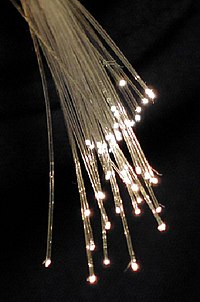
Photo from wikipedia
A novel optical fiber Vernier effect (VE) biosensor based on cascading Sagnac loops embedded with excessively tilted fiber grating (ExTFG) is proposed for the label free and specific detection of… Click to show full abstract
A novel optical fiber Vernier effect (VE) biosensor based on cascading Sagnac loops embedded with excessively tilted fiber grating (ExTFG) is proposed for the label free and specific detection of canine distemper virus (CDV). The VE was realized by cascading two different Sagnac loops with similar free spectrum range (FSR), one of which was integrated with panda‐type polarization maintaining fiber (PMF) as the reference loop, and the other was embedded with ExTFG as the sensing loop. Owning to the amplified function of the VE, the refractive index (RI) sensitivity of the proposed sensing structure reached −1914.89 nm/RIU, which is approximately 12 times higher than that of the single ExTFG based RI sensor. Furthermore, the ExTFG in sensing loop was modified by graphene oxide (GO) and bio‐functionalized by the CDV monoclonal antibodies (anti‐CDV MAbs) for the specific detection of the CDV. Experimental results show that the proposed optical fiber Vernier sensor could detect the CDV in buffer solution with concentration as low as 1 pg/mL, and the sensitivity was about −1.18 nm/[log(mg/ml)] in the concentration range of 1 pg/mL ~ 50 ng/mL. The excellent specific and clinical properties of the biosensor were verified by immunoassays for fetal bovine serum, Toxoplasma gondii, rabies virus and CDV serum in sequence. Due to the sensitivity amplification function of VE, dense comb spectrum of the Sagnac loop and the stable interference spectra maintained by the polarized light, the proposed biosensor possesses the combined advantages of high sensitivity, high Q‐factor and high stability, which may have potential applications in biosensing fields.
Journal Title: Journal of Biophotonics
Year Published: 2022
Link to full text (if available)
Share on Social Media: Sign Up to like & get
recommendations!